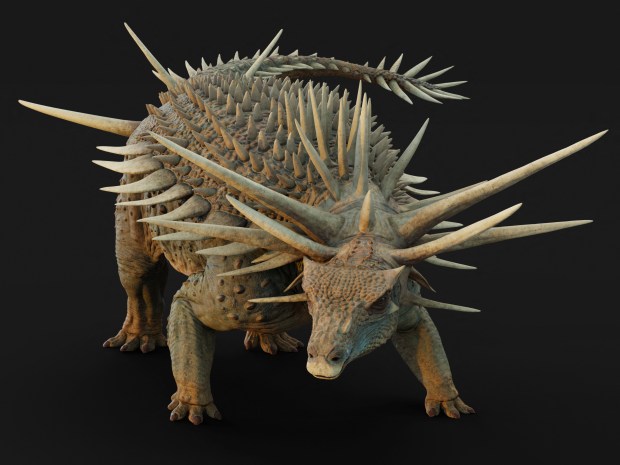Science
Scientists Uncover Unique Spikes of 165-Million-Year-Old Dino

A team of scientists has revealed that a newly studied dinosaur, known as Spicomellus, sported extraordinary metre-long spikes extending from its neck, a feature likely evolved as a defense mechanism against predators. This discovery provides new insights into the evolutionary history of ankylosaurs, a group of herbivorous dinosaurs characterized by their armoured bodies. The findings were published in the esteemed scientific journal Nature.
The Spicomellus, which roamed the Earth approximately 165 million years ago, is described as one of the most unusual dinosaurs ever discovered. The fossils, unearthed in Boulemane, Morocco, revealed that the dinosaur possessed bony spikes fused to its ribs, a rare anatomical feature not observed in any other vertebrate species, either living or extinct.
Significance of the Discovery
Professor Richard Butler from the University of Birmingham, who co-led the research, emphasized the significance of this find. He stated, “Spicomellus is one of the strangest dinosaurs that we’ve ever discovered. It’s utterly unlike any other found anywhere else in the world.” This discovery not only enhances the understanding of the ankylosaur lineage but also captures the imagination of those interested in prehistoric life.
The new fossils provided crucial details about the dinosaur’s morphology. The spikes, measuring up to 87 centimetres, emerged from a bony collar around its neck, which may have been even longer during the creature’s lifetime. Professor Susannah Maidment, co-leader of the research from the Natural History Museum in London, described the fossils as “absolutely bizarre” and stated that they are reshaping the understanding of how these armoured dinosaurs evolved.
Evolutionary Insights and Behavior
The unique morphology of the Spicomellus raises intriguing questions about its behavior. While it is likely that the spikes initially evolved for protection, they may also have played a role in mating displays and competition among rivals. Professor Maidment noted, “We’ve never seen anything like this in any animal before,” highlighting the distinctive nature of this dinosaur’s anatomy.
The initial recognition of the Spicomellus species began when Professor Maidment acquired a rib bone from a fossil dealer in Cambridge in 2019. This acquisition led to further explorations and the eventual unearthing of additional fossils, significantly expanding the knowledge surrounding the species.
The exploration of the Spicomellus provides a clearer picture of the diversity of ankylosaurs and their evolutionary adaptations. With its unique body armor and an array of spines, this dinosaur exemplifies the fascinating evolutionary paths taken by prehistoric creatures.
The findings about Spicomellus not only enrich the narrative of dinosaur evolution but also serve to inspire further research into the complex histories of these ancient animals.
-

 Entertainment4 weeks ago
Entertainment4 weeks agoAimee Osbourne Joins Family for Emotional Tribute to Ozzy
-

 Politics1 month ago
Politics1 month agoDanny Healy-Rae Considers Complaint After Altercation with Garda
-

 Top Stories2 weeks ago
Top Stories2 weeks agoIreland Enjoys Summer Heat as Hurricane Erin Approaches Atlantic
-

 World1 month ago
World1 month agoHawaii Commemorates 80 Years Since Hiroshima Bombing with Ceremony
-

 Top Stories1 month ago
Top Stories1 month agoFianna Fáil TDs Urgently Consider Maire Geoghegan-Quinn for Presidency
-

 World1 month ago
World1 month agoGaza Aid Distribution Tragedy: 20 Killed Amid Ongoing Violence
-

 World1 month ago
World1 month agoCouple Convicted of Murdering Two-Year-Old Grandson in Wales
-

 Top Stories1 month ago
Top Stories1 month agoClashes Erupt Between Far-Right Groups and Migrants in Spain
-

 World1 month ago
World1 month agoAristocrat Constance Marten and Partner Convicted of Infant Murder
-

 Top Stories1 month ago
Top Stories1 month agoHistoric Dalkey Pub The Queens Reopens Under New Management
-

 World1 month ago
World1 month agoTrump Defends FBI Deputy Director Amid Epstein Files Controversy
-

 Politics1 month ago
Politics1 month agoTragic Crowd Surge at Gaza Aid Center Claims 20 Lives









